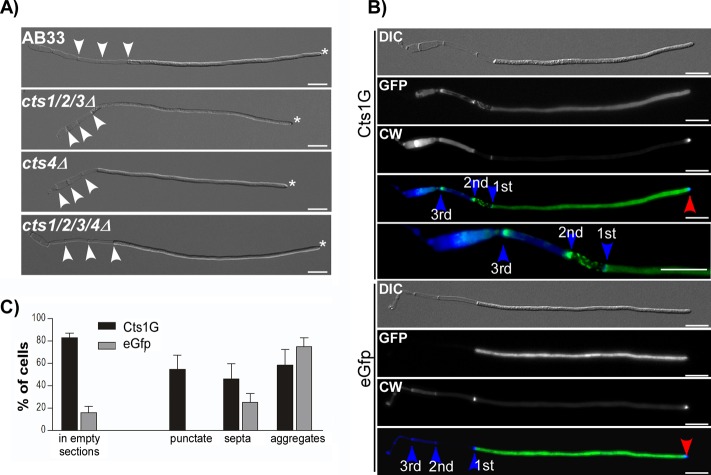FIG 5.
Chitinases are dispensable for filament formation but still localize to empty sections. (A) Microscopic analysis of AB33 and corresponding chitinase-deficient strains. Even strains which lack all chitinolytic enzymes are able to establish unipolar filaments. All strains show a single growing pole (asterisks) and insert septa at the basal pole (arrowheads). Scale bars, 10 μm. (B) Fluorescence microscopic colocalization analysis of Cts1G in filaments. Cts1G localizes in the cytosol and in distinct patterns at the cell wall of empty sections, such as punctate localization (mainly the first empty section), accumulation at septa, and random aggregates (mainly in old empty sections beyond the second retraction septum). In the cytosol, Cts1G abundance gradually increases toward the hyphal tip, as described before (18). Free cytosolic EGFP is distributed equally throughout the cytoplasm. No accumulation is observable in empty sections. Septa are highlighted by blue and the growth poles by red arrowheads. Scale bars, 10 μm. (C) Quantification of localization patterns. Elongated filaments with at least three empty sections were identified based on the DIC image. Subsequently, the localization of the GFP signal in empty sections was scored in at least 100 images for each strain. A total of 83.1% of all cells expressed Cts1G (n = 181), but only 15.9% of EGFP cells (n = 139) showed EGFP signal in empty sections. Further scoring of cells with signal inside the empty sections (n = 150 for Cts1G, n = 22 for EGFP) into the different patterns clarified that free EGFP occasionally aggregates, whereas punctate localization, which is typical for Cts1G, was never observed in cytosolic EGFP-expressing cells. Error bars show standard deviations from three independent experiments. The quantification was repeated three times with similar results.

